Study on Spectral Response and Estimation of Grassland Plants Dust Retention Based on Hyperspectral Data
Abstract
1. Introduction
2. Materials and Methods
2.1. Study Areas
2.2. Dust Retention Content and Leaf Spectrum Measurement
2.3. Airborne Hyperspectral Data Acquisition and Preprocessing
2.4. Two-dimensional Correlation Spectroscopy
2.5. Feature Bands Selection and Estimation Model
3. Results
3.1. Dust Retention Content Variability
3.2. Comparison of Leaf Spectra before and after Dust Removal
3.3. Two-Dimensional Correlation Spectra of Plants Dust Retention
3.3.1. Two-Dimensional Correlation Analysis of Dust Retention in Leaves
3.3.2. Two-Dimensional Correlation Analysis of Dust Retention in the Canopy
3.4. Estimate of Canopy Dust Retention Based on Feature Analysis
3.5. Spatial Distribution Features of Canopy Dust
4. Discussion
4.1. Effects of Dust on Leaf Spectra
4.2. Sensitive Spectral Analysis of Leaf and Canopy Dust Retention
4.3. Accuracy Evaluation of the Estimation Model
4.4. Future Work
5. Conclusions
Author Contributions
Funding
Acknowledgments
Conflicts of Interest
References
- Ahrens, M.J.; Morrisey, D.J. Biological effects of unburnt coal in the marine environment. Oceanogr. Mar. Biol. 2005, 43, 69–122. [Google Scholar]
- Benitez-Polo, Z.; Velasco, L.A. Effects of suspended mineral coal dust on the energetic physiology of the Caribbean scallop Argopecten nucleus (Born, 1778). Environ. Pollut. 2020, 260, 114000. [Google Scholar] [CrossRef] [PubMed]
- Leghari, S.K.; Zaidi, M.A.; Siddiqui, M.F.; Sarangzai, A.M.; Sheikh, S.; Arsalan. Dust exposure risk from stone crushing to workers and locally grown plant species in Quetta, Pakistan. Environ. Monit. Assess. 2019, 191, 1–13. [Google Scholar] [CrossRef]
- Lu, J.; Lei, S.G. Research Overview of Effect of Dust on Environment and Its Diffusion Laws in Open-pit Coal Mine. Saf. Coal Mines 2017, 48, 231–234. [Google Scholar]
- Rai, P.K.; Panda, L.L.S. Dust capturing potential and air pollution tolerance index (APTI) of some road side tree vegetation in Aizawl, Mizoram, India: An Indo-Burma hot spot region. Air Qual. Atmos. Health 2014, 7, 93–101. [Google Scholar] [CrossRef]
- Hirano, T.; Kiyota, M.; Aiga, I. Physical effects of dust on leaf physiology of cucumber and kidney bean plants. Environ. Pollut. 1995, 89, 255–261. [Google Scholar] [CrossRef]
- Naidoo, G.; Chirkoot, D. The effects of coal dust on photosynthetic performance of the mangrove, Avicennia marina in Richards Bay, South Africa. Environ. Pollut. 2004, 127, 359–366. [Google Scholar] [CrossRef]
- Yang, H.L.; Wei, L.L.; Ye, X.H.; Liu, G.F.; Yang, X.J.; Huang, Z.Y. Effects of coal dust deposition on seedling growth of Hedysarum laeve Maxim., a dominant plant species on Ordos Plateau. Acta Ecol. Sin. 2016, 36, 2858–2865. [Google Scholar]
- Guo, J.Y.; He, J.L.; Li, J.R.; Xing, E.D.; Wen, A.S.; Liu, Y.P.; Yang, G.Y. Effects of different measures on water erosion control of dump slope at opencast coal mine in typical steppe. Trans. Chin. Soc. Agric. Eng. 2015, 31, 296–303. [Google Scholar]
- Chen, Y.W.; Liu, G.J.; Gong, Y.M.; Yang, J.L.; Qi, C.C.; Gao, L.F. Release and enrichment of 44 elements during coal pyrolysis of Yima coal, China. J. Anal. Appl. Pyrol. 2007, 80, 283–288. [Google Scholar]
- Kronbauer, M.A.; Izquierdo, M.; Dai, S.; Waanders, F.B.; Wagner, N.J.; Mastalerz, M.; Hower, J.C.; Oliveira, M.L.S.; Taffarel, S.R.; Bizani, D.; et al. Geochemistry of ultra-fine and nano-compounds in coal gasification ashes: A synoptic view. Sci. Total Environ. 2013, 456–457, 95–103. [Google Scholar] [CrossRef] [PubMed]
- Liu, X.Y.; Shi, H.D.; Bai, Z.K.; Zhou, W.; Liu, K.; Wang, M.H.; He, Y.J. Heavy metal concentrations of soils near the large opencast coal mine pits in China. Chemosphere 2020, 244, 125360. [Google Scholar] [CrossRef] [PubMed]
- Eviner, V.T.; Chapin III, F.S. Functional Matrix: A Conceptual Framework for Predicting Multiple Plant Effects on Ecosystem Processes. Annu. Rev. Ecol. Evol. Syst. 2003, 34, 455–485. [Google Scholar] [CrossRef]
- Díaz, S.; Cabido, M. Vive la différence: Plant functional diversity matters to, ecosystem processes. Trends Ecol. Evol. 2001, 16, 646–655. [Google Scholar] [CrossRef]
- Li, Y.J.; Zhao, N.; Cao, Y.E.; Yang, J.J. Effects of coal dust deposition on the physiological properties of plants in an open-pit coal mine. Acta Ecol. Sin. 2018, 38, 8129–8138. [Google Scholar]
- Chaston, K.; Doley, D. Mineral particulates and vegetation: Effects of coal dust, overburden and flyash on light interception and leaf temperature. Clean Air Environ. Qual. 2006, 40, 40–44. [Google Scholar]
- Spencer, S. Effects of coal dust on species composition of mosses and lichens in an arid environment. J. Arid Environ. 2001, 49, 843–853. [Google Scholar] [CrossRef]
- Weng, Q.H. Land use change analysis in the Zhujiang Delta of China using satellite remote sensing, GIS and stochastic modelling. J. Environ. Manag. 2002, 64, 273–284. [Google Scholar] [CrossRef]
- Zhao, S.H.; Wang, Q.; Li, Y.; Liu, S.H.; Wang, Z.T.; Zhu, L.; Wang, Z.F. An overview of satellite remote sensing technology used in China’s environmental protection. Earth Sci. Inform. 2017, 10, 137–148. [Google Scholar] [CrossRef]
- Li, D.R. Towards the Development of Remote Sensing and GIS in the 21st Century. Geomat. Inf. Sci. Wuhan Univ. 2003, 28, 127–131. [Google Scholar]
- Shi, T.Z.; Chen, Y.Y.; Liu, Y.L.; Wu, G.F. Visible and near-infrared reflectance spectroscopy—An alternative for monitoring soil contamination by heavy metals. J. Hazard. Mater. 2014, 265, 166–176. [Google Scholar] [CrossRef] [PubMed]
- Tan, K.; Wang, H.M.; Zhang, Q.Q.; Jia, X.P. An improved estimation model for soil heavy metal(loid) concentration retrieval in mining areas using reflectance spectroscopy. J. Soil Sediment 2018, 18, 2008–2022. [Google Scholar] [CrossRef]
- Landmann, T.; Piiroinen, R.; Makori, D.M.; Abdel-Rahman, E.M.; Makau, S.; Pellikka, P.; Raina, S.K. Application of hyperspectral remote sensing for flower mapping in African savannas. Remote Sens. Environ. 2015, 166, 50–60. [Google Scholar] [CrossRef]
- Roth, K.L.; Roberts, D.A.; Dennison, P.E.; Alonzo, M.; Peterson, S.H.; Beland, M. Differentiating plant species within and across diverse ecosystems with imaging spectroscopy. Remote Sens. Environ. 2015, 167, 135–151. [Google Scholar] [CrossRef]
- Haboudane, D. Hyperspectral vegetation indices and novel algorithms for predicting green LAI of crop canopies: Modeling and validation in the context of precision agriculture. Remote Sens. Environ. 2004, 90, 337–352. [Google Scholar] [CrossRef]
- Stagakis, S.; Markos, N.; Sykioti, O.; Kyparissis, A. Monitoring canopy biophysical and biochemical parameters in ecosystem scale using satellite hyperspectral imagery: An application on a Phlomis fruticosa Mediterranean ecosystem using multiangular CHRIS/PROBA observations. Remote Sens. Environ. 2010, 114, 977–994. [Google Scholar] [CrossRef]
- Wang, J.; Xu, R.S.; Ma, Y.L.; Miao, L.; Cai, R.; Chen, Y. The research of air pollution based on spectral features in leaf surface of Ficus microcarpa in Guangzhou, China. Environ. Monit. Assess. 2008, 142, 73–83. [Google Scholar] [CrossRef]
- Jing, W.L.; Zhou, X.; Zhang, C.; Wang, C.Y.; Jiang, H. Machine Learning for Estimating Leaf Dust Retention Based on Hyperspectral Measurements. J. Sens. 2018, 2018, 1–12. [Google Scholar] [CrossRef]
- Chudnovsky, A.; Ben-Dor, E. Application of visible, near-infrared, and short-wave infrared (400–2500 nm) reflectance spectroscopy in quantitatively assessing settled dust in the indoor environment. Case study in dwellings and office environments. Sci. Total Environ. 2008, 393, 198–213. [Google Scholar] [CrossRef]
- Zhang, P.F.; GULI, J.; Yin, J.Q.; Bao, A.M.; Yao, F.; Liu, J.P. Using Hyperspectral Indices to Measure the effect of Mine Dust on the Growth of Three Typical Desert Plants. Spectrosc. Spect. Anal. 2014, 34, 2162–2168. [Google Scholar]
- Peng, J.; Xiang, H.Y.; Wang, J.Q.; Ji, W.J.; Liu, W.Y.; Chi, C.M.; Zuo, T.G. Quantitative model of foliar dustfall content using hyperspectral remote sensing. J. Infrared Millim. Waves 2013, 32, 343. [Google Scholar] [CrossRef]
- Li, W.T.; Wu, J.; Chen, T.S.; Peng, D.L. Hyperspectral estimation model of dust deposition content on plant leaves. Trans. Chin. Soc. Agric. Eng. 2016, 32, 180–185. [Google Scholar]
- Xu, J.H.; Yu, J.T. Air Dustfall Impact on Spectrum of Ficus microcarpa’s Leaf. Adv. Mater. Res. 2013, 655–657, 813–815. [Google Scholar] [CrossRef]
- Peng, J.; Wang, J.Q.; Xiang, H.Y.; Niu, J.L.; Chi, C.M.; Liu, W.Y. Effect of Foliar Dustfall Content (FDC) on High Spectral Characteristics of Pear Leaves and Remote Sensing Quantitative Inversion of FDC. Spectrosc. Spect. Anal. 2015, 35, 1365–1369. [Google Scholar]
- Ong, C.; Cudahy, T.; Caccetta, M.; Hick, P.; Piggott, M. Quantifying dust loading on mangroves using hyperspectral techniques. In Proceedings of the IEEE International Geoscience & Remote Sensing Symposium, Sydney, Australia, 9–13 July 2001; Volume 1, pp. 296–298. [Google Scholar]
- Wang, H.; Fang, N.; Yan, X.; Chen, F.; Xiong, Q.; Zhao, W. Retrieving Dustfall Distribution in Beijing City Based on Ground Spectral Data and Remote Sensing. Spectrosc. Spect. Anal. 2016, 36, 2911–2918. [Google Scholar]
- Yan, X.; Shi, W.Z.; Zhao, W.J.; Luo, N.N. Mapping dustfall distribution in urban areas using remote sensing and ground spectral data. Sci. Total Environ. 2015, 506–507, 604–612. [Google Scholar] [CrossRef]
- Kayet, N.; Pathak, K.; Chakrabarty, A.; Kumar, S.; Chowdary, V.M.; Singh, C.P.; Sahoo, S.; Basumatary, S. Assessment of foliar dust using Hyperion and Landsat satellite imagery for mine environmental monitoring in an open cast iron ore mining areas. J. Clean. Prod. 2019, 218, 993–1006. [Google Scholar] [CrossRef]
- Sims, D.A.; Gamon, J.A. Relationships between leaf pigment content and spectral reflectance across a wide range of species, leaf structures and developmental stages. Remote Sens. Environ. 2002, 81, 337–354. [Google Scholar] [CrossRef]
- Yu, Y.; Song, Z.L.; Fan, W.Y.; Yang, X.G. Scale Conversion from Canopy Spectra and Leaf Spectra. Geomat. Inf. Sci. Wuhan Univ. 2018, 43, 1560–1565. [Google Scholar]
- Darvishzadeh, R.; Skidmore, A.; Schlerf, M.; Atzberger, C.; Corsi, F.; Cho, M. LAI and chlorophyll estimation for a heterogeneous grassland using hyperspectral measurements. ISPRS J. Photogramm. 2008, 63, 409–426. [Google Scholar] [CrossRef]
- Lee, C.; Yang, W.; Parr, R.G. Development of the Colle-Salvetti correlation-energy formula into a functional of the electron density. Phys. Rev. B Condens. Matter. 1988, 37, 785–789. [Google Scholar] [CrossRef]
- Chen, W.; Habibul, N.; Liu, X.Y.; Yu, H.Q. FTIR and Synchronous Fluorescence Heterospectral Two-Dimensional Correlation Analyses on the Binding Characteristics of Copper onto Dissolved Organic Matter. Environ. Sci. Technol. 2015, 49, 2052–2058. [Google Scholar] [CrossRef] [PubMed]
- Li, J.R.; Sun, S.Q.; Wang, X.X.; Xu, C.H.; Chen, J.B.; Zhou, Q.; Lu, G.H. Differentiation of five species of Danggui raw materials by FTIR combined with 2D-COS IR. J. Mol. Struct. 2014, 1069, 229–235. [Google Scholar] [CrossRef]
- Li, H.D.; Liang, Y.Z.; Xu, Q.S.; Cao, D.S. Key wavelengths screening using competitive adaptive reweighted sampling method for multivariate calibration. Anal. Chim. Acta. 2009, 648, 77–84. [Google Scholar] [CrossRef] [PubMed]
- Zhang, J.; Tian, H.Q.; Wang, D.; Li, H.J.; Mouazen, A.M. A Novel Approach for Estimation of Above-Ground Biomass of Sugar Beet Based on Wavelength Selection and Optimized Support Vector Machine. Remote Sens. 2020, 12, 620. [Google Scholar] [CrossRef]
- Lin, L.X.; Wang, Y.J.; Teng, J.Y.; Xi, X.X. Hyperspectral Analysis of Soil Total Nitrogen in Subsided Land Using the Local Correlation Maximization-Complementary Superiority (LCMCS) Method. Sensors 2015, 15, 17990–18011. [Google Scholar] [CrossRef] [PubMed]
- Chen, W.; Qian, C.; Liu, X.Y.; Yu, H.Q. Two-Dimensional Correlation Spectroscopic Analysis on the Interaction between Humic Acids and TiO2 Nanoparticles. Environ. Sci. Technol. 2014, 48, 11119–11126. [Google Scholar] [CrossRef]
- Noda, I. Close-up view on the inner workings of two-dimensional correlation spectroscopy. Vib. Spectrosc. 2012, 60, 146–153. [Google Scholar] [CrossRef]
- Sexton, R.S.; Dorsey, R.E.; Johnson, J.D. Optimization of neural networks: A comparative analysis of the genetic algorithm and simulated annealing. Eur. J. Oper. Res. 1999, 114, 589–601. [Google Scholar] [CrossRef]
- Breiman, L.; Breiman, L.; Cutler, R.A. Random Forests Machine Learning. J. Clin. Microbiol. 2001, 2, 199–228. [Google Scholar]
- Liang, L.; Di, L.P.; Zhang, L.P.; Deng, M.X.; Qin, Z.H.; Zhao, S.H.; Lin, H. Estimation of crop LAI using hyperspectral vegetation indices and a hybrid inversion method. Remote Sens. Environ. 2015, 165, 123–134. [Google Scholar] [CrossRef]
- Tobler, W.R. A computer movie simulating urban growth in the Detroit region. Econ. Geogr. 1970, 46, 234–240. [Google Scholar] [CrossRef]
- Yu, Y.F.; He, T.G.; Song, T.Q.; Li, L.J.; Wei, C.H.; Meng, Y.C.; Tang, H.Q.; Li, Z.Y.; Li, T.T.; Hu, F. Spatial variability of limestone soil nutrients in a Karst area of Northwestern Guangxi. Acta Ecol. Sin. 2018, 38, 2906–2914. [Google Scholar]
- Liu, B.H.; Zhao, D.C.; Zhang, P.Y.; Liu, F.C.; Jia, M.; Liang, J. Seedling evaluation of six walnut rootstock species originated in China based on principal component analysis and cluster analysis. Sci. Hortic. 2020, 265, 109212. [Google Scholar] [CrossRef]
- Noda, I. Generalized Two-Dimensional Correlation Method Applicable to Infrared, Raman, and Other Types of Spectroscopy. Appl. Spectrosc. 1993, 47, 1329–1336. [Google Scholar] [CrossRef]
- Niu, W.; Jiang, Z.A.; Tian, D.M. Numerical simulation of the factors influencing dust in drilling tunnels: Its application. Min. Sci. Technol. 2011, 21, 11–15. [Google Scholar]
- Liu, L.Y. Principle and Application of Quantitative Remote Sensing of Vegetation; Science Press: Beijing, China, 2014. [Google Scholar]
- Thompson, J.R.; Mueller, P.W.; Flückiger, W.; Rutter, A.J. The effect of dust on Photosynthesis and its significance for roadside Plants. Environ. Pollut. Ser. A Ecol. Biol. 1984, 34, 171–190. [Google Scholar] [CrossRef]
- Gupta, A.; Kumar, R.; Maharaj Kumari, K.; Srivastava, S.S. Atmospheric dry deposition to leaf surfaces at a rural site of India. Chemosphere 2004, 55, 1097–1107. [Google Scholar] [CrossRef] [PubMed]
- Pang, B.; Zhang, Y.L.; Wang, D. The characteristic of particulate size and heavy metal in foliar dust and surface dust from different urban areas. Ecol. Environ. Sci. 2009, 18, 1312–1317. [Google Scholar]
- Neves, N.R.; Oliva, M.A.; Da Cruz Centeno, D.; Costa, A.C.; Ribas, R.F.; Pereira, E.G. Photosynthesis and oxidative stress in the restinga plant species Eugenia uniflora L. exposed to simulated acid rain and iron ore dust deposition: Potential use in environmental risk assessment. Sci. Total Environ. 2009, 407, 3740–3745. [Google Scholar] [CrossRef]
- Wang, Q.; Li, P.H. Hyperspectral indices for estimating leaf biochemical properties in temperate deciduous forests: Comparison of simulated and measured reflectance data sets. Ecol. Indic. 2012, 14, 56–65. [Google Scholar] [CrossRef]
- Zhou, X.F.; Huang, W.J.; Kong, W.P.; Ye, H.C.; Dong, Y.Y.; Casa, R. Assessment of leaf carotenoids content with a new carotenoid index: Development and validation on experimental and model data. Int. J. Appl. Earth Obs. 2017, 57, 24–35. [Google Scholar] [CrossRef]
- Feilhauer, H.; Asner, G.P.; Martin, R.E. Multi-method ensemble selection of spectral bands related to leaf biochemistry. Remote Sens. Environ. 2015, 164, 57–65. [Google Scholar] [CrossRef]
- Chen, F.; Zhou, Z.X.; Xiao, R.B.; Wang, P.C.; Li, H.F.; Guo, E.X. Estimation of ecosystem services of urban green-land in industrial areas:A case study on green-land in the workshop area of the Wuhan Iron and Steel Company. Acta Ecol. Sin. 2006, 26, 2229–2236. [Google Scholar]
- Hallik, L.; Niinemets, Ü.; Kull, O. Photosynthetic acclimation to light in woody and herbaceous species: A comparison of leaf structure, pigment content and chlorophyll fluorescence characteristics measured in the field. Plant Biol. 2012, 14, 88–99. [Google Scholar] [CrossRef]
- Zarco-Tejada, P.J.; Miller, J.R.; Noland, T.L.; Mohammed, G.H.; Sampson, P.H. Scaling-up and model inversion methods with narrowband optical indices for chlorophyll content estimation in closed forest canopies with hyperspectral data. IEEE Trans. Geosci. Remote Sens. 2001, 39, 1491–1507. [Google Scholar] [CrossRef]
- Tiwari, R.K.; Gupta, A.K. Effect of dust and vehicular emissions on leaf area and biochemical constituents of road side herbs in Varanasi. Plant Arch. 2010, 10, 767–771. [Google Scholar]
- Lin, F.F.; Ding, X.D.; Fu, Z.P.; Deng, J.S.; Shen, Z.Q. Application of Mutual Information to Variable Selection in Diagnosis of Phosphorus Nutrition in Rice. Spectrosc. Spect. Anal. 2009, 29, 2467–2470. [Google Scholar]
- Liu, L.Y.; Zhang, S.; Zhang, B. Evaluation of hyperspectral indices for retrieval of canopy equivalent water thickness and gravimetric water content. Int. J. Remote Sens. 2016, 37, 3384–3399. [Google Scholar] [CrossRef]
- Escobedo, F.J.; Nowak, D.J. Spatial heterogeneity and air pollution removal by an urban forest. Landsc. Urban Plan. 2009, 90, 102–110. [Google Scholar] [CrossRef]
- Li, W.; Jiang, C.H.; Chen, Y.W.; Hyyppa, J.; Tang, L.L.; Li, C.R.; Wang, S.W. A Liquid Crystal Tunable Filter-Based Hyperspectral LiDAR System and Its Application on Vegetation Red Edge Detection. IEEE Geosci. Remote Sens. Lett. 2019, 16, 291–295. [Google Scholar] [CrossRef]
- Jiang, C.H.; Chen, Y.W.; Wu, H.H.; Li, W.; Zhou, H.; Bo, Y.M.; Shao, H.; Song, S.J.; Puttonen, E.; Hyyppä, J. Study of a High Spectral Resolution Hyperspectral LiDAR in Vegetation Red Edge Parameters Extraction. Remote Sens. 2019, 11, 2007. [Google Scholar] [CrossRef]
- Asner, G.P.; Martin, R.E.; Anderson, C.B.; Knapp, D.E. Quantifying forest canopy traits: Imaging spectroscopy versus field survey. Remote Sens. Environ. 2015, 158, 15–27. [Google Scholar] [CrossRef]
- Xuan, J. The effects of turbulence and complex terrain on dust emissions and depositions from coal stockpiles. Atmos. Environ. 1994, 28, 1951–1960. [Google Scholar] [CrossRef]
- Mahapatra, P.S.; Ray, S.; Das, N.; Mohanty, A. Urban air-quality assessment and source apportionment studies for Bhubaneshwar, Odisha. Theor. Appl. Climatol. 2013, 112, 243–251. [Google Scholar] [CrossRef]
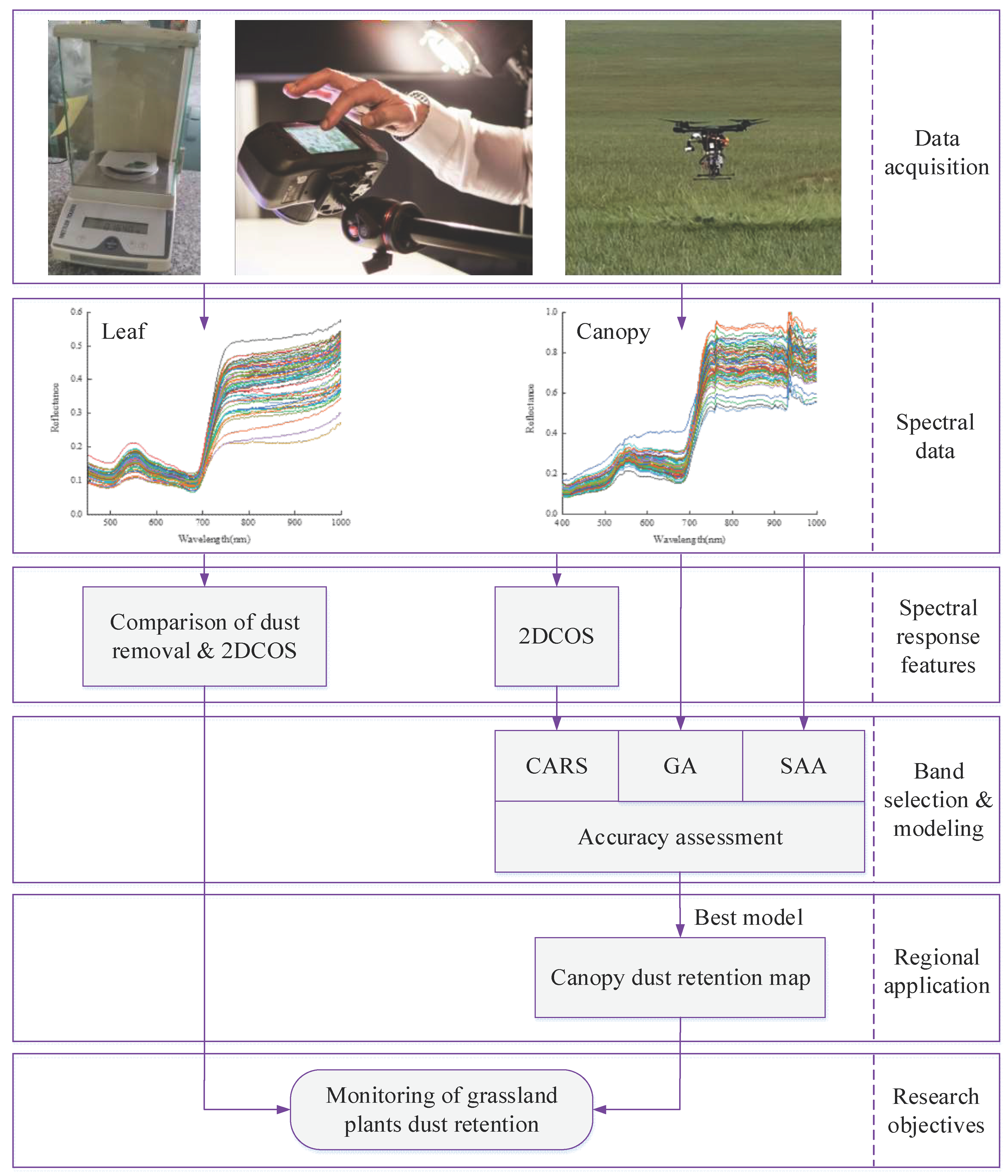
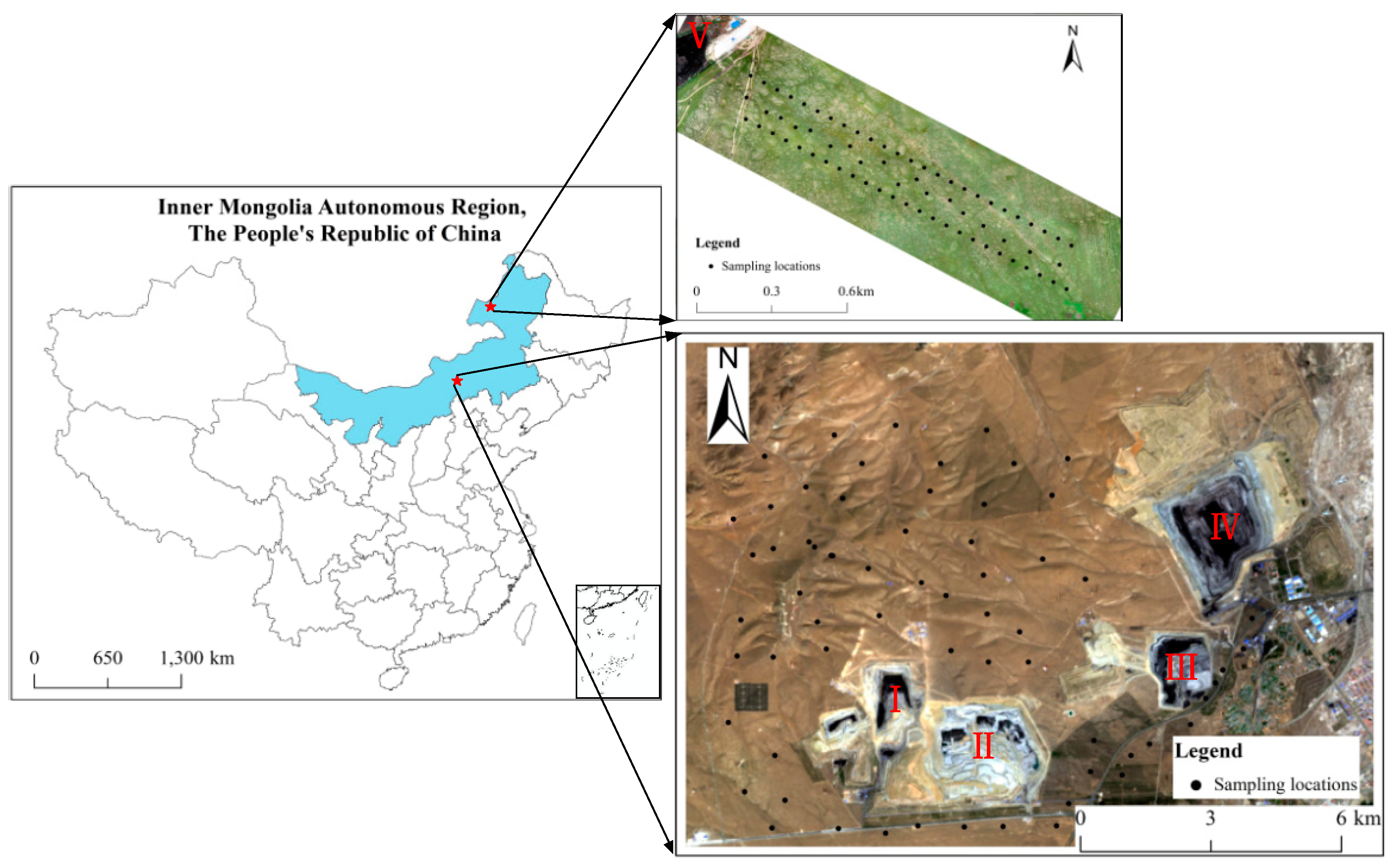
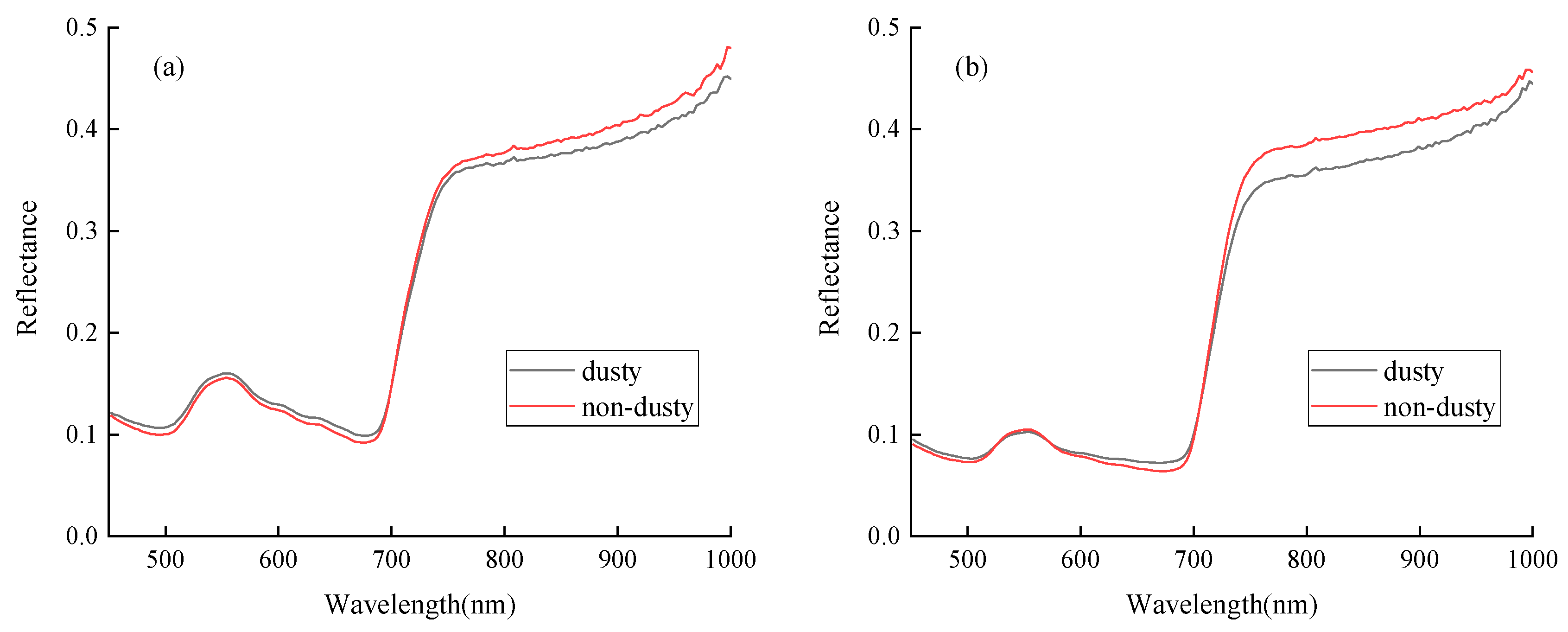
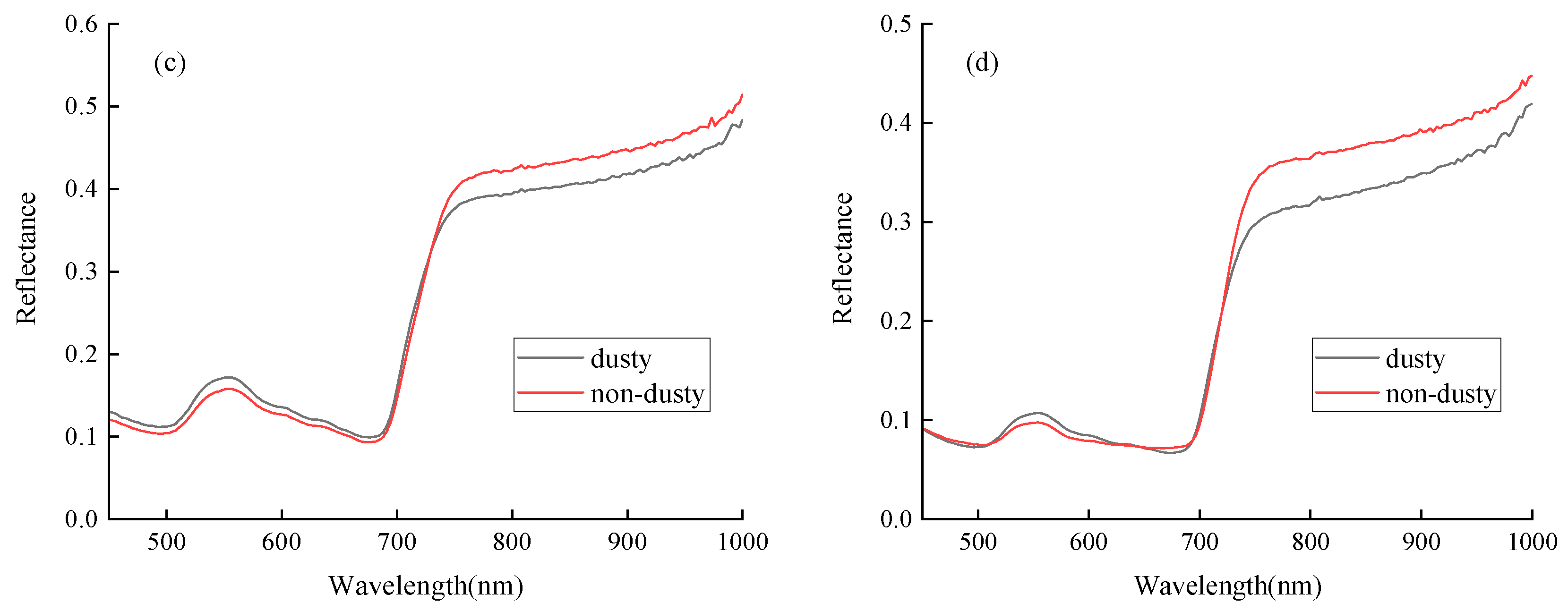


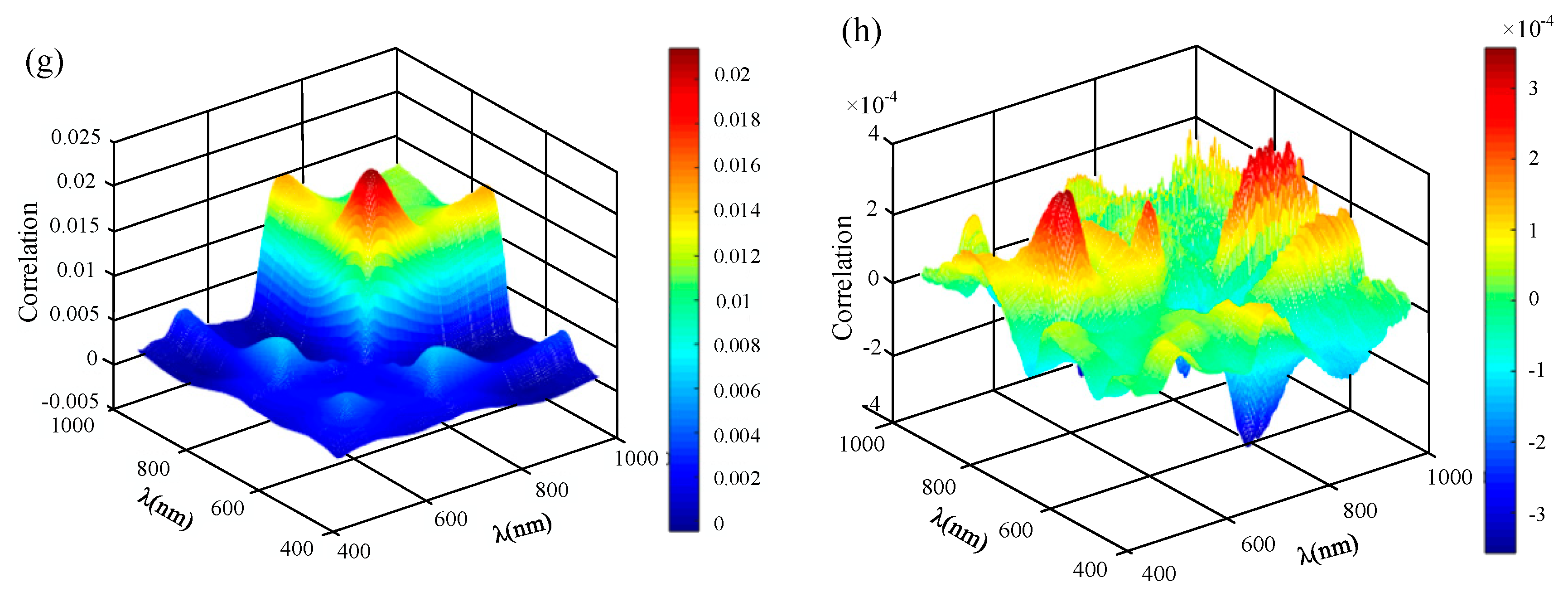

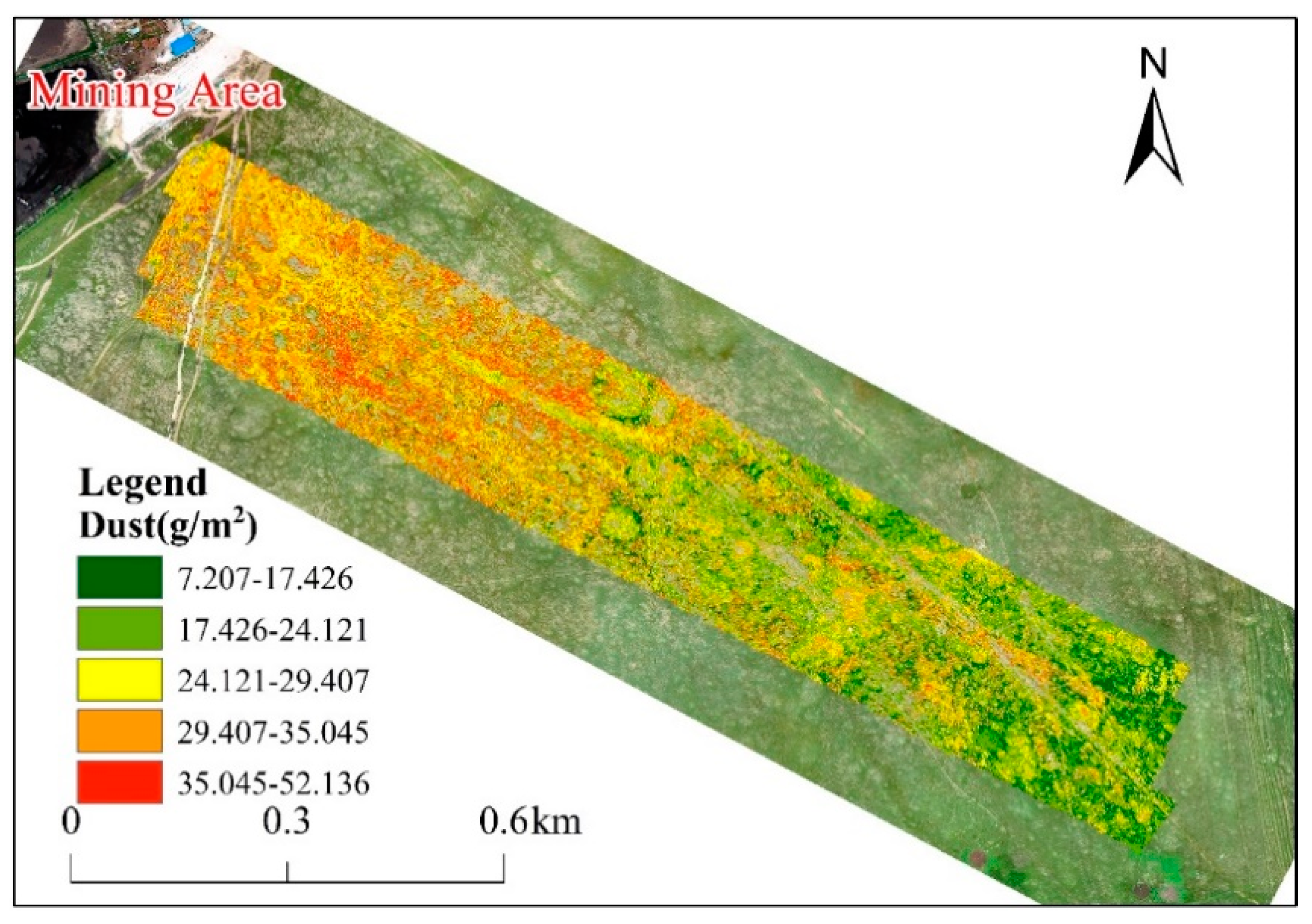




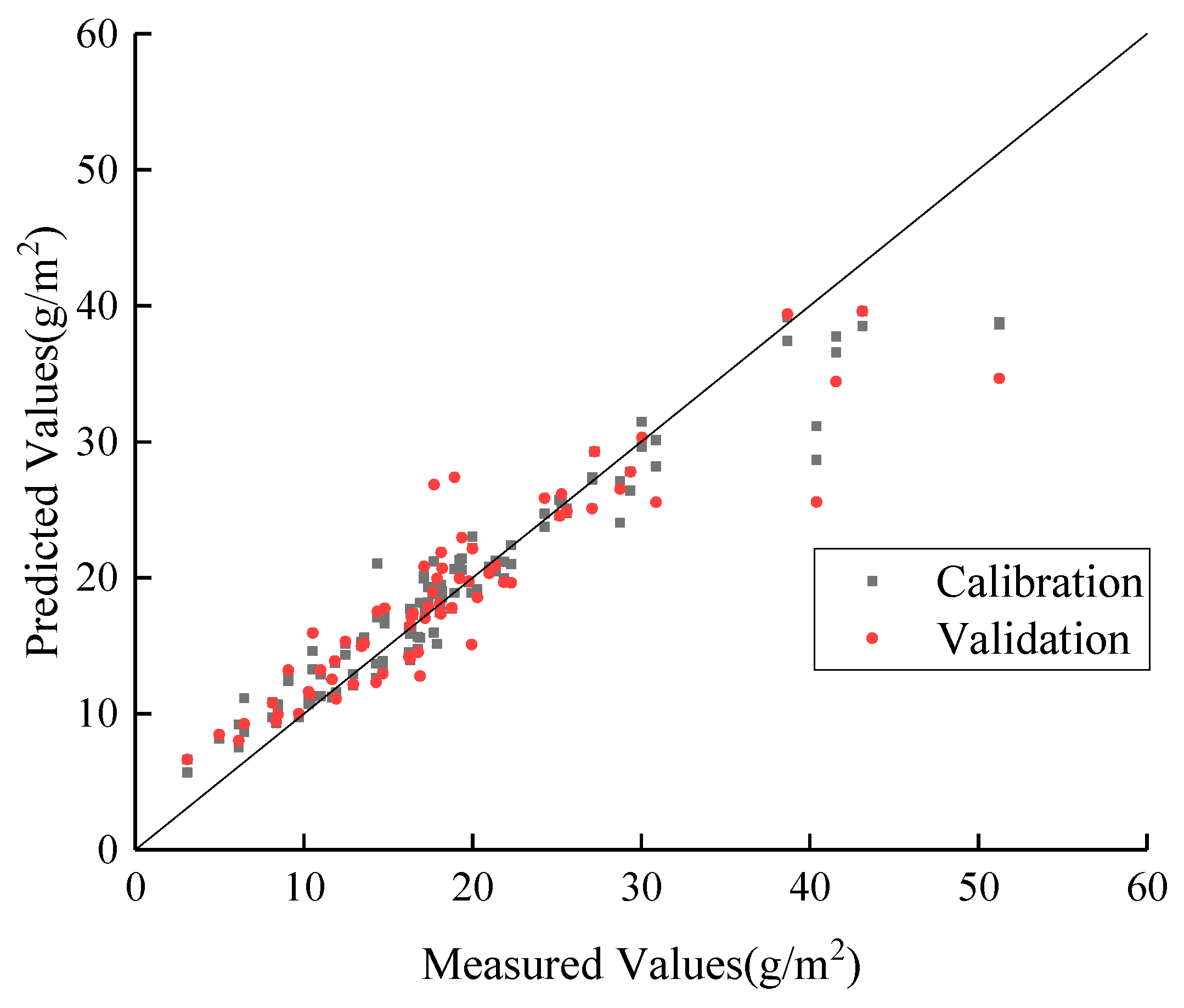
| Plant Species | Min | Max | Mean | SD a | C.V |
|---|---|---|---|---|---|
| Leymus chinensis | 0.353 | 51.425 | 13.303 | 12.230 | 89.299% |
| Cleistogenes squarrosa | 1.813 | 52.810 | 16.649 | 10.232 | 51.665% |
| Potentilla acaulis | 2.441 | 62.064 | 18.656 | 9.638 | 91.930% |
| Scutellaria scordifolia | 0.532 | 47.312 | 12.574 | 11.228 | 61.454% |
| Canopy | 1.486 | 54.688 | 16.969 | 8.996 | 53.014% |
| Model | Calibration | Validation | |||
|---|---|---|---|---|---|
| RPD | |||||
| 2DCOS-CARS-RF | 0.909 | 2.775 | 0.820 | 3.910 | 2.357 |
| GA-RF | 0.808 | 4.041 | 0.682 | 5.199 | 1.772 |
| SAA-RF | 0.837 | 3.722 | 0.740 | 4.697 | 1.962 |
© 2020 by the authors. Licensee MDPI, Basel, Switzerland. This article is an open access article distributed under the terms and conditions of the Creative Commons Attribution (CC BY) license (http://creativecommons.org/licenses/by/4.0/).
Share and Cite
Zhao, Y.; Lei, S.; Yang, X.; Gong, C.; Wang, C.; Cheng, W.; Li, H.; She, C. Study on Spectral Response and Estimation of Grassland Plants Dust Retention Based on Hyperspectral Data. Remote Sens. 2020, 12, 2019. https://doi.org/10.3390/rs12122019
Zhao Y, Lei S, Yang X, Gong C, Wang C, Cheng W, Li H, She C. Study on Spectral Response and Estimation of Grassland Plants Dust Retention Based on Hyperspectral Data. Remote Sensing. 2020; 12(12):2019. https://doi.org/10.3390/rs12122019
Chicago/Turabian StyleZhao, Yibo, Shaogang Lei, Xingchen Yang, Chuangang Gong, Cangjiao Wang, Wei Cheng, Heng Li, and Changchao She. 2020. "Study on Spectral Response and Estimation of Grassland Plants Dust Retention Based on Hyperspectral Data" Remote Sensing 12, no. 12: 2019. https://doi.org/10.3390/rs12122019
APA StyleZhao, Y., Lei, S., Yang, X., Gong, C., Wang, C., Cheng, W., Li, H., & She, C. (2020). Study on Spectral Response and Estimation of Grassland Plants Dust Retention Based on Hyperspectral Data. Remote Sensing, 12(12), 2019. https://doi.org/10.3390/rs12122019





